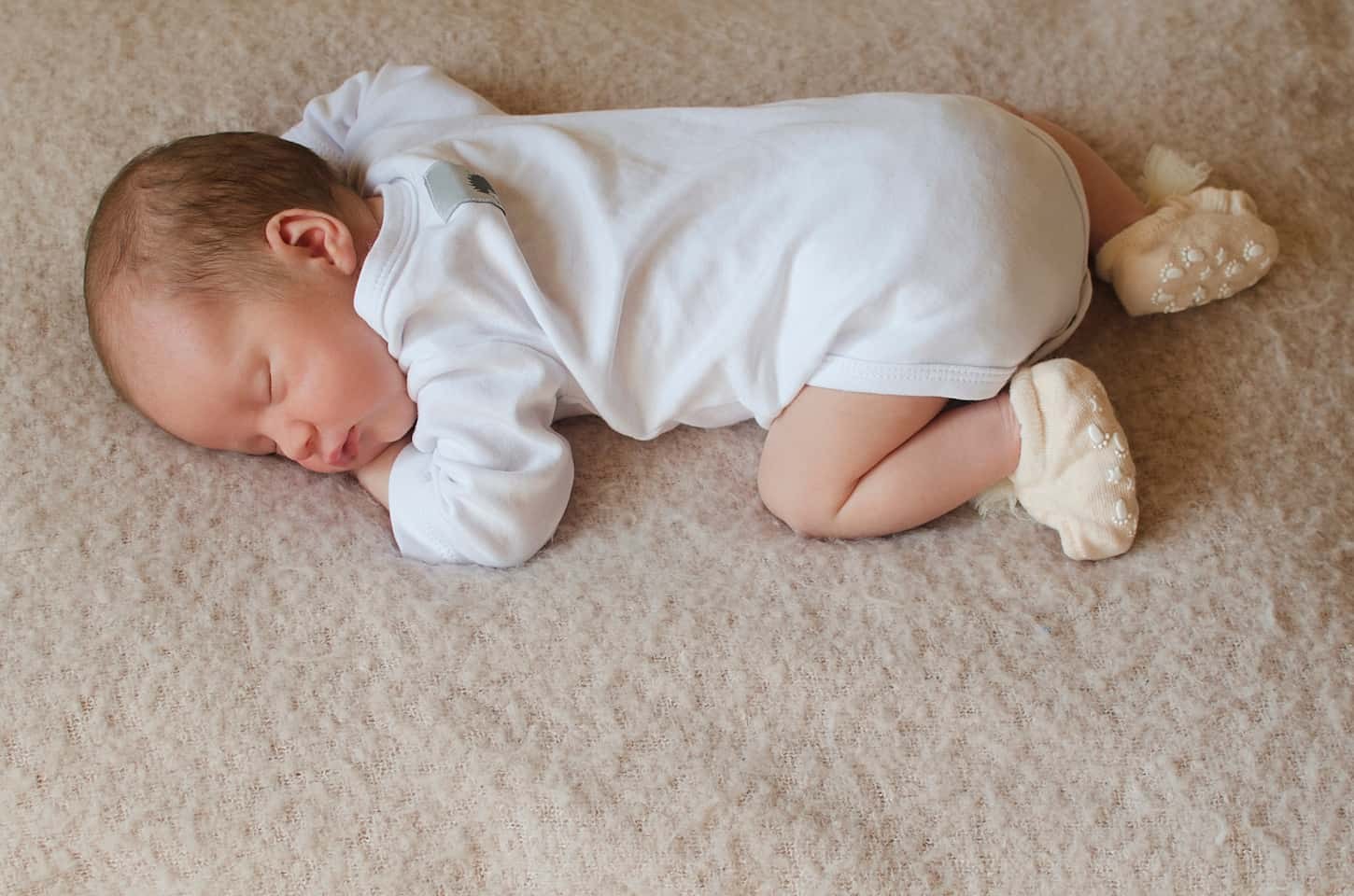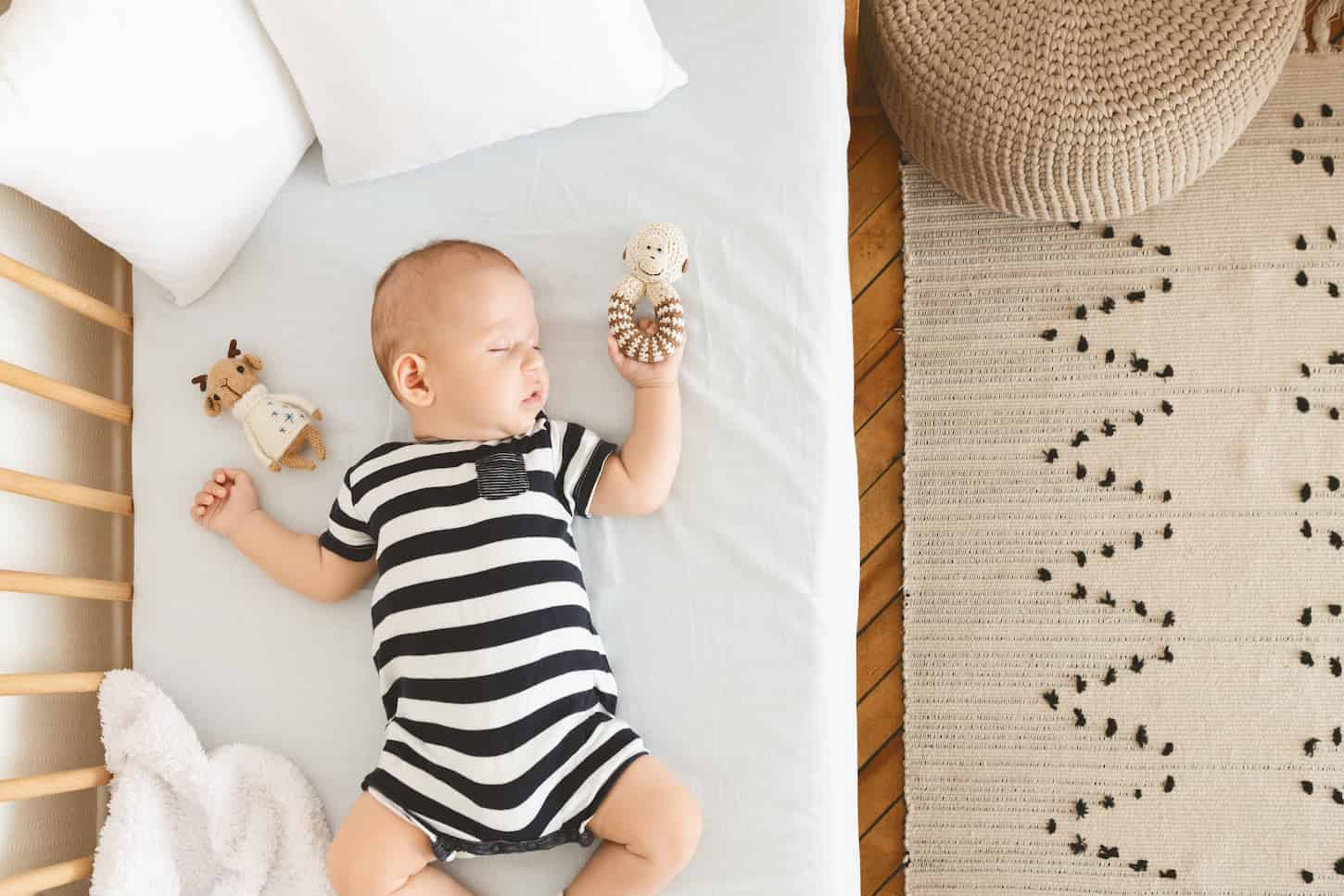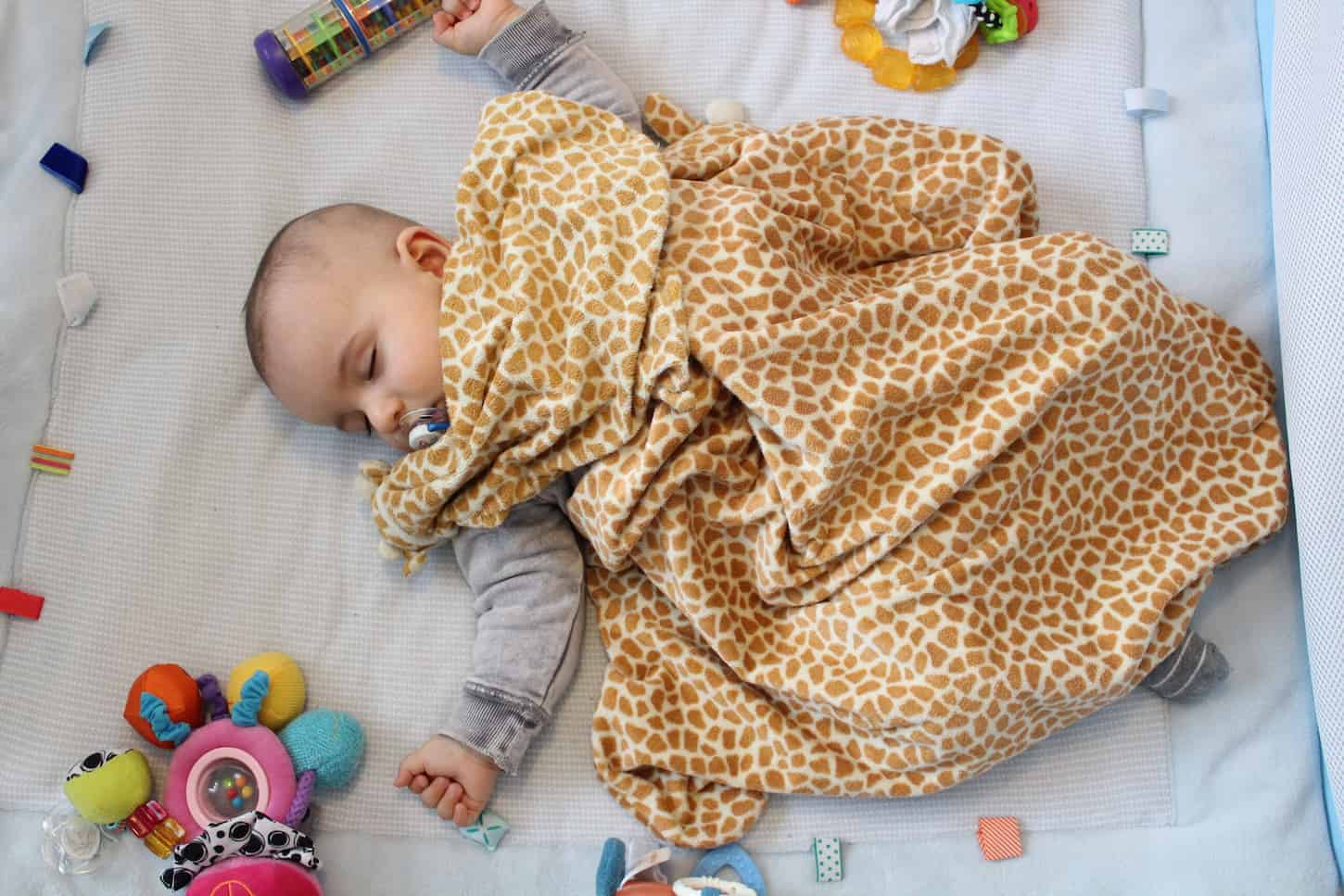There’s nothing cuter than a sleeping baby. Of course, sometimes my kids sleep in the weirdest configurations. And they’ve slept like that since they were little. And this is a question I get asked a lot – is it normal for babies to sleep in weird positions?
Babies and toddlers can sleep comfortably in a variety of positions that look strange or uncomfortable to adults. Children are generally safe sleeping in such weird positions as long as they can breathe easily, are their normal color, and are not snoring.
Even so, let’s talk about some of the normal (but weird) sleeping positions babies manage to get into. And we’ll talk about how to make sure they’re safe, too.

Why Babies Think it’s Normal to Sleep in Weird Positions
Babies don’t actually think much about how they’re sleeping. They just… sleep. And that often means that they’re just going to sleep where they’re at – in whatever position they’re at.
Here are a few of the weirdest positions I’ve seen my children fall asleep (and stay asleep!) in.
- My baby was standing up holding onto the crib’s railing when they just kind of… fell asleep. Sometimes while still holding onto the crib railing or slats.
- They were kneeling and fell asleep – so now their butt’s up in the air.
- They were banging their head against the side of the crib – and they fell asleep with their head smashed up against the side of the crib.
- My children have fallen asleep sitting up in a chair.
Kids sleep in weird positions. And they really don’t think about it. They’re just tired – so they go to sleep. As a child, my kid sister fell asleep walking up the stairs. I think she was four at the time. In any case, we found her sprawled across three stairs.
So babies (and toddlers and even school-aged children) aren’t thinking that they’re falling asleep in weird positions. They’re just too exhausted to do much but fall asleep. They just happen to be in a weird position that doesn’t bother them enough to move.
Is Sleeping in a Weird Position a Problem for Children?
Usually, sleeping in a weird position isn’t an issue. There are three times that it is a problem, though.
- If the baby is having difficulty breathing.
- If the child is snoring – as snoring means they’re having difficulty breathing.
- If your child isn’t their normal color.
Those are the three big things to watch for, as any one of those being off is a signal that they aren’t breathing well and should be repositioned. If you’ve got more than two of those issues at the same time, then repositioning them immediately is your first step.
If that doesn’t fix the problem, please call your doctor or 911.
But beyond that? Kids sleep in strange positions. And, for them anyway, it can be totally normal.
Why do Babies Sleep with Their Butt in the Air?
Have you ever caught your baby asleep kneeling down? There’s a good chance you’ve taken a look at your monitor and seen your baby with their butt in the air. It might look uncomfortable to you but as long as they are sleeping soundly, there is no need to them wake up.
In your womb, your baby is all curled up and is quite content that way. Even though they now have a crib to spread out around, they tend to feel secure in a position familiar to them.
If they have recently begun crawling, they could have been moving around their crib and ended up falling asleep in that position. It might look a little weird but, don’t worry, there is nothing wrong with your baby. They probably were practicing their crawling skills when they fell asleep.

Should you Reposition a Sleeping Baby?
Once a baby can roll over on its own, there is no need to reposition a sleeping baby. You likely will wake them if you try. While some positions they get themselves into can be alarming to you, they find it quite comfortable.
If it appears like they are stuck in the slates of their crib, you certainly should work to help them out of that position to avoid injury. Try to do it as quietly and discreetly as possible to avoid waking them up.
Anything that could be a safety concern should be addressed, even if it wakes your baby during an attempt at repositioning.
Now, there is one other time you should reposition a baby. This is usually with smaller babies, though. It’s this: to reduce the risk of plagiocephaly (flat head syndrome).
A newborn’s head is very soft and moldable which makes them prone to flat head syndrome (plagiocephaly). Make sure you rotate which side of your baby’s head they sleep on. Repositioning their head will help prevent flat spots from forming.
What Position Should a Newborn Sleep in?
To help prevent Sudden Infant Death Syndrome (SIDS), newborns should always be put down to sleep on their back. A brand new baby doesn’t have the neck strength to move their head around if they are put down on their stomach.
A newborn doesn’t need anything more than a completely flat sleeping surface free of clutter. A newborn shouldn’t have any blankets or stuffed animals in their crib that could potentially cover their face during their sleep.
While you should continue to place babies on their backs for sleep, once a baby can roll over on their own, you don’t have to flip them back. Babies usually can roll back and forth for around 6 months.
Can Babies Sleep on a Slight Incline?
The American Academy of Pediatrics (AAP) does not recommend babies be put in an incline position, even a slight one, for bed. They discourage the use of products that provide an incline, like the Rock ‘n Play or a sleeping wedge, for sleep.
Placing a baby to sleep on an incline can increase the chance of suffocation or strangulation. The AAP suggests, that even if your baby is suffering from reflux, putting them on their backs on a flat surface is best.
The only times I’ve seen a pediatrician recommend letting baby sleep on a slight incline were if the baby was so congested that it had to be inclined to sleep. In those cases, the pediatrician recommended propping up the legs on one side of the crib a few inches.
That way, the baby is inclined ever so slightly – but it’s the whole crib and far less likely to be a safety issue. If you think your baby should sleep on an incline, please be sure to talk to your pediatrician about it first.

Can You Move a Sleeping Baby?
Moving a sleeping baby is definitely a master trick. Only some parents are ever able to accomplish it (spoiler: I wasn’t able to master it, even after 4 children!). So if you can’t master it, don’t despair.
Whether you master moving a sleeping baby or not, there is nothing worse than a baby falling asleep in the car right before you get home. It is not recommended to leave a sleeping baby in a car seat, so you’re actually encouraged to move them to a safe sleeping space.
Don’t try to rush the process of the transport. If you move too fast, you likely will wake up your baby. Try to go nice and slow and avoid creating any loud noises.
As you are laying them down, try to be as level with the crib as possible. With a few ninja-like moves you can gracefully move babies from your arms down to their mattress. Don’t forget to slam the door on your way out!
If they just fell asleep, they will be more likely to wake up when you move them. Try to wait until they are in a deeper sleep, if possible. If they stir during your first attempt, give it 15 minutes before you try again.
If you can’t master this process, don’t worry. You still have options.
- Learn to be a ninja at the timing of things. Maybe don’t risk a trip in the car around naptimes.
- Bring a book in the car so that you can stay in the car next to your napping child in the car seat. It’s not ideal – but it’s much safer than leaving a child unattended in a car seat.
As you add more children to the equation, timing does get harder. My older children have gotten really good at quietly exiting the car to go inside and play while I sit next to a sleeping baby and read for the rest of the unplanned car nap.
Is it OK if my Baby Sleeps Face Down?
Never put a baby face-down to sleep. Always put them on their back.
If newborn baby sleeps face down, they are more susceptible to SIDS because they are not strong enough to turn their head to breathe easier. When face down, babies re-breath the air they just exhaled, which can contain large levels of carbon monoxide.
However, as your baby begins to become stronger and is rolling around more, you likely will find them face down from time to time. Once they do this on their own, don’t feel the need to reposition them.
As mentioned above, babies should always be placed on their backs to sleep. This stays valid until they turn one. By then, they are out of the SIDS risk window (more on this later) and can roll around while sleeping with relative safety.
Why Do Babies Sleep in the Frog Position?
Have you ever seen your baby sleeping in a position that mimics that of a frog and wondered if it was normal? A baby sleeping curled up like a frog is very similar to how they were positioned in the womb. While in your belly, they are completely folded up and will have a bowed spine for quite sometime after they are born.
You likely will notice this more in the first month or two of their life. As they get older, they will be less likely to find themselves copying the amphibian. Once they start having more control of their limbs, they will search for new positions to sleep in.
When Can I Stop Worrying About Positioning my Baby to Prevent SIDS?
You will hear the saying “back is best” until your baby turns one. This saying is to help prevent SIDS.
SIDS reaches its peak risk at about 2-4 months of age and starts to go down at 6-8 months. It is very rare after the age of one. Following sleep safety guidelines will ensure a safe night’s sleep for your baby.
While your baby will more than likely begin rolling over before the age of one, you should still always start them off on their back. They will end up in whichever position is most comfortable for them, but starting them off on their back is still the pediatrician-recommended way to prevent SIDS.

Final Thoughts on Weird Sleeping Positions
Babies and children are weird – but the cute kind of weird. And when they sleep in weird positions, they’re still cute.
I know it can be concerning to think about babies sleeping in that weird, kneeling with their behind in the air position.
But here’s a fun physiological fact: children’s kneecaps don’t calcify into bones until they’re 2 or 3 years old. Meaning that they really don’t mind kneeling when they sleep – and their feet aren’t going to fall asleep no matter how oddly they’re sleep-kneeling.
So before you stress about babies getting stiff from sleeping in weird positions, remember that they’re still growing. Most of their bones are nowhere near that of an adult. So they’ll be just fine sleeping in that weird position.
Let them sleep, friend. And go get some rest while they’re sleeping if you can.